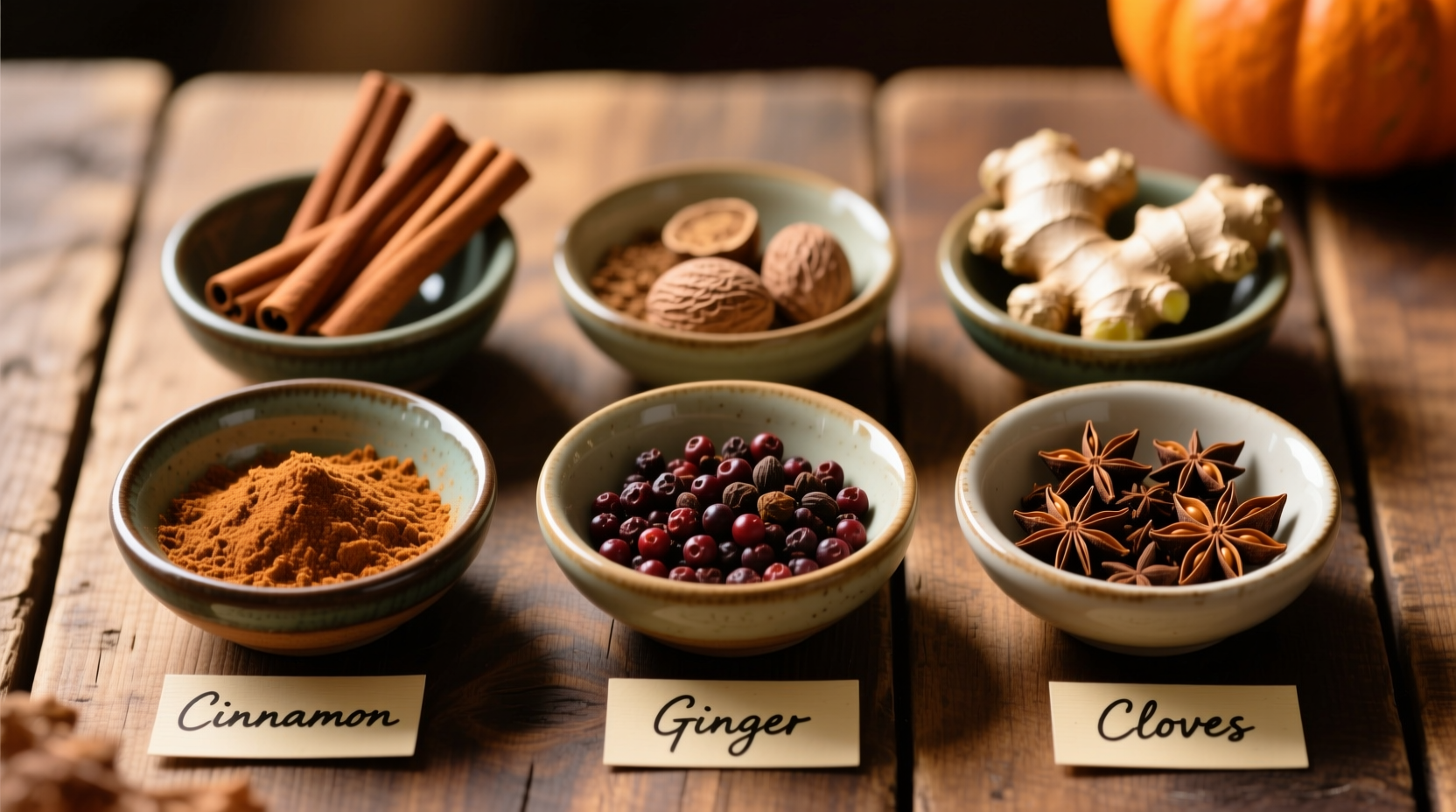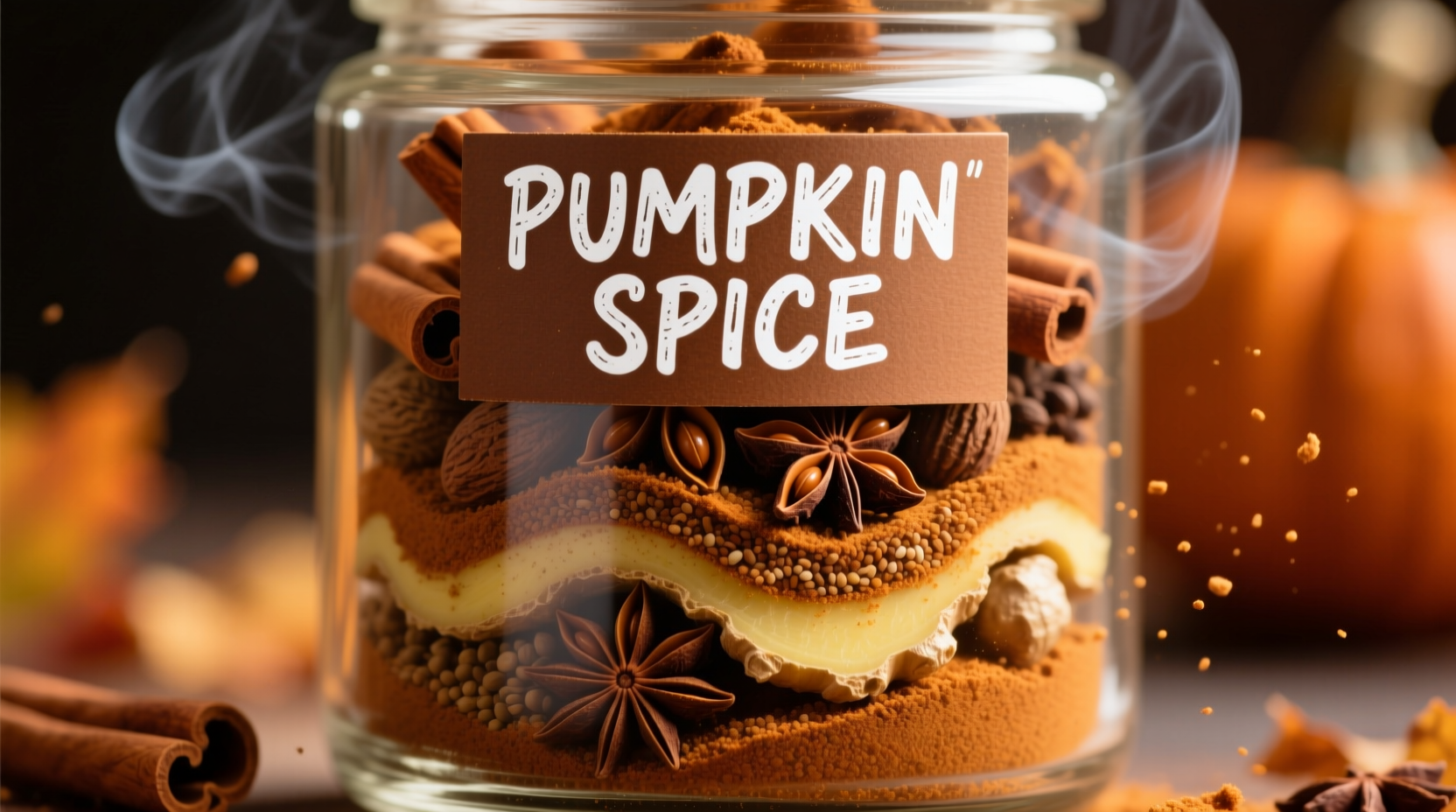Every fall, pumpkin spice dominates menus, shelves, and social media—but what exactly are you tasting when you enjoy that seasonal latte or baked good? Despite its name, pumpkin spice contains no actual pumpkin. This beloved flavor profile comes entirely from a carefully balanced blend of warming spices that complement pumpkin's natural sweetness in traditional recipes.
Breaking Down the Core Components
Understanding what's in pumpkin spice requires examining each ingredient's role in creating that distinctive autumnal flavor. Let's explore the five essential spices that form this iconic blend:
Cinnamon: The Foundation (60-70%)
Ceylon cinnamon provides the dominant base note in most commercial blends. Its sweet, woody aroma creates the familiar backbone of pumpkin spice. Higher quality blends use true cinnamon (Cinnamomum verum) rather than the more common Cassia variety, which contains higher levels of coumarin—a compound that can be problematic in large quantities according to the FDA's food safety guidelines.
Ginger: The Brightener (15-20%)
Freshly ground ginger adds a citrusy zing that cuts through the blend's sweetness. This Southeast Asian native (Zingiber officinale) has been used in baking for centuries. Its active compound, gingerol, provides both flavor and potential digestive benefits documented by researchers at the National Center for Complementary and Integrative Health.
Nutmeg: The Secret Weapon (8-12%)
Often the most misunderstood component, nutmeg (Myristica fragrans) adds complexity with its warm, slightly sweet profile. Freshly grated nutmeg makes a significant difference in flavor intensity compared to pre-ground versions. The USDA Food Composition Database notes that nutmeg contains myristicin, which contributes to its distinctive aroma but should be consumed in moderation.
Allspice: The Unifier (5-8%)
Despite its name, allspice (Pimenta dioica) isn't a blend but a single berry that tastes like a combination of cinnamon, nutmeg, and cloves. Native to the Caribbean, this spice creates harmony between the other components. Food historians at the Culinary Institute of America note that allspice became popular in American baking during colonial times when spices were expensive and hard to obtain.
Cloves: The Accent (2-5%)
Used sparingly, cloves (Syzygium aromaticum) provide that signature "pumpkin pie" finish with their intense, slightly medicinal note. Their main compound, eugenol, is so potent that exceeding 5% in the blend can overwhelm other flavors. The International Journal of Food Science published research confirming that proper clove比例 is critical for balanced spice blends.
| Spice | Standard Ratio | Flavor Profile | Common Substitutes |
|---|---|---|---|
| Cinnamon | 60-70% | Sweet, woody, warm | Cassia (stronger, more bitter) |
| Ginger | 15-20% | Citrusy, zesty, slightly spicy | Galingale (more floral) |
| Nutmeg | 8-12% | Warm, nutty, slightly sweet | Mace (more delicate) |
| Allspice | 5-8% | Complex: cinnamon+nutmeg+cloves | None (unique flavor) |
| Cloves | 2-5% | Intense, medicinal, sweet | Star anise (different profile) |
Why It's Called "Pumpkin" Spice (When There's No Pumpkin)
The naming confusion stems from culinary history. When European settlers arrived in North America, they adopted Native American techniques for preparing pumpkins. Traditional pumpkin pie recipes from the 17th and 18th centuries called for "pumpion pie" seasoned with available spices. As food historian Sarah Johnson explains: "Before canned pumpkin existed, cooks would simply list 'pumpkin pie spices' in recipes, referring to the specific blend used with pumpkin dishes."
Evolution of the Blend: A Historical Timeline
The pumpkin spice blend evolved significantly over centuries:
- 1650s: Early American "pumpion" recipes used available spices like cinnamon and ginger, but no standardized blend
- 1800s: Commercial spice companies began selling "pumpkin pie spice" as convenience products
- 1950s: McCormick created the first standardized pumpkin pie spice blend we recognize today
- 2003: Starbucks introduced the Pumpkin Spice Latte, transforming the blend from baking ingredient to cultural phenomenon
- 2020s: Artisanal variations emerge with regional twists and premium ingredients
Commercial vs. Homemade: Understanding the Differences
Store-bought pumpkin spice often contains additional ingredients that affect both flavor and quality:
- Anti-caking agents: Most commercial blends include silicon dioxide or calcium silicate to prevent clumping
- Sugar: Some "pumpkin spice flavored" products contain added sugar, misleading consumers about the actual spice blend
- Filler ingredients: Lower quality blends may contain rice flour or other bulking agents
For authentic flavor control, making your own blend ensures freshness and customization. The Specialty Coffee Association notes that freshly blended spices release more aromatic compounds, enhancing the sensory experience in beverages.
Practical Applications Beyond the Obvious
While pumpkin spice is synonymous with fall beverages, its culinary applications extend far beyond:
- Baking: Use 1-2 teaspoons per cup of flour in muffins, breads, and cookies
- Savory dishes: Add to roasted root vegetables or autumn soups for depth
- Breakfast: Sprinkle on oatmeal or yogurt for instant flavor enhancement
- Cocktails: Infuse spirits or rim glasses with the spice blend
- Household: Create natural air fresheners by simmering spices with water
Professional chefs recommend adjusting ratios based on application: increase ginger for beverages, boost cinnamon for baking, and reduce cloves for savory applications. The Culinary Research & Education Academy emphasizes that understanding these context boundaries prevents flavor imbalances in different culinary applications.
Storage and Freshness Tips
Spice quality degrades over time. For optimal pumpkin spice flavor:
- Store in airtight containers away from light and heat
- Use within 6 months for homemade blends (commercial blends last 12-18 months)
- Freeze whole spices and grind as needed for maximum freshness
- Perform the "sniff test"—if aroma is weak, it's time to replace
Food scientists at the University of Massachusetts Amherst have demonstrated that proper storage preserves volatile compounds responsible for spice aromas, directly impacting flavor quality.

Creating Your Perfect Blend
Customizing your pumpkin spice allows personalization for specific recipes or dietary needs:
- For sensitive palates: Reduce cloves to 1% and increase cinnamon to 75%
- For baking: Add a pinch of cardamom for complexity
- Sugar-free version: Ensure no fillers or sweeteners are added
- Extra warming blend: Increase ginger and add a touch of black pepper
When making your own blend, always use whole spices and grind them fresh. The difference in flavor intensity between pre-ground and freshly ground spices is significant—research published in the Journal of Food Science shows freshly ground spices release up to 40% more aromatic compounds.
Frequently Asked Questions
Here are answers to the most common questions about pumpkin spice composition:
Does pumpkin spice contain actual pumpkin?
No, pumpkin spice contains no pumpkin. It's a blend of cinnamon, ginger, nutmeg, allspice, and cloves traditionally used to flavor pumpkin pie. The name refers to its historical use with pumpkin dishes, not its ingredients.
What's the difference between pumpkin pie spice and pumpkin spice?
There is no difference—these terms are used interchangeably. Both refer to the same blend of cinnamon, ginger, nutmeg, allspice, and cloves. Some regional variations exist, but the core components remain consistent.
Can I substitute pumpkin spice with individual spices?
Yes, use 3 teaspoons cinnamon, 2 teaspoons ginger, 2 teaspoons nutmeg, 1.5 teaspoons allspice, and 1 teaspoon cloves to make 10 teaspoons of pumpkin spice blend. Adjust ratios to taste for your specific recipe.
Is pumpkin spice healthy?
The spices in pumpkin spice blend offer potential health benefits including antioxidants and anti-inflammatory compounds. However, many commercial products containing pumpkin spice also include added sugars and calories. The spices themselves are calorie-free and nutrient-dense when used in moderation.











 浙公网安备
33010002000092号
浙公网安备
33010002000092号 浙B2-20120091-4
浙B2-20120091-4